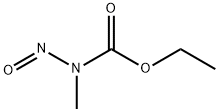N-Methyl-N-nitrosourethane is a nitrosamide which causes chromosomal damage in HeLa cells. It is also used in the synthesis of antifungal agents such as azoxybacillin.
ChEBI: N-Nitroso-N-methylurethane is a carboxylic ester.
N-NITROSO-N-METHYLURETHANE is a N-nitrosated carbamate ester. Incompatible with strong acids and bases. Especially incompatible with strong reducing agents such as hydrides. Flammable gaseous hydrogen may be produced by the combination with active metals or nitrides Incompatible with oxidizing acids, peroxides, and hydroperoxides.
TOXIC; inhalation, ingestion or skin contact with material may cause severe injury or death. Contact with molten substance may cause severe burns to skin and eyes. Avoid any skin contact. Effects of contact or inhalation may be delayed. Fire may produce irritating, corrosive and/or toxic gases. Runoff from fire control or dilution water may be corrosive and/or toxic and cause pollution.
Non-combustible, substance itself does not burn but may decompose upon heating to produce corrosive and/or toxic fumes. Some are oxidizers and may ignite combustibles (wood, paper, oil, clothing, etc.). Contact with metals may evolve flammable hydrogen gas. Containers may explode when heated.
Confirmed carcinogen
with experimental carcinogenic,
tumorigenic, and teratogenic data. Poison by
ingestion, intraperitoneal, subcutaneous, and
intravenous routes. Moderately toxic by inhalation. Experimental reproductive
effects. Mutation data reported. Has been
implicated as a transplacental brain
carcinogen. Combustible when exposed to
heat, sparks, open flame, and powerful
oxidizers. Explodes when heated. A storage
hazard. When heated to decomposition it
emits toxic fumes of NOx.
